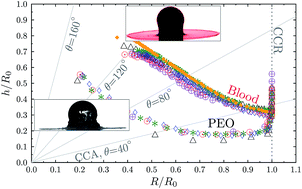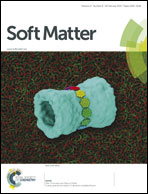Classifying dynamic contact line modes in drying drops†
Abstract
Although the evaporation mode of sessile droplets is almost universally characterized as either constant contact radius (CCR) or constant contact angle (CCA), here we investigate two alternatives where the contact line speed is either constant or inversely proportional to the droplet radius. We present supporting evidence from our experiments on poly(ethylene oxide) (PEO) polymer solutions and blood, and from literature on pure and binary liquids, colloidal suspensions, soft substrates, reactive dewetting and hole nucleation. We introduce the use of novel “clock-drop” images to visualize droplet evolution and dimensionless height–radius plots to characterize the evaporative pathways. Combining these with a simple scaling argument, we show that receding speed is inversely proportional to the three-phase contact radius R, with a constant of proportionality A, which is dependent on the drying conditions and drop shape, but independent of drop volume. We have shown that this is equivalent to a linear decrease in contact area with time. By varying only A, which we achieved experimentally by choosing solutions whose precipitate constricts after deposition, the evaporation mode can be altered continuously to include the two established modes CCR and CCA, and two new modes which we term “slowly receding” and “rapidly receding”, which are characterised by fully dried “doughnut” and “pillar” deposits respectively.


 Please wait while we load your content...
Please wait while we load your content...